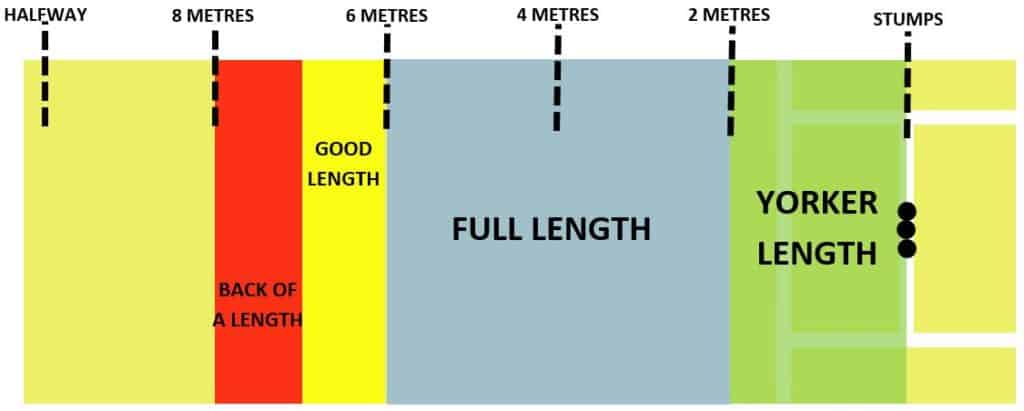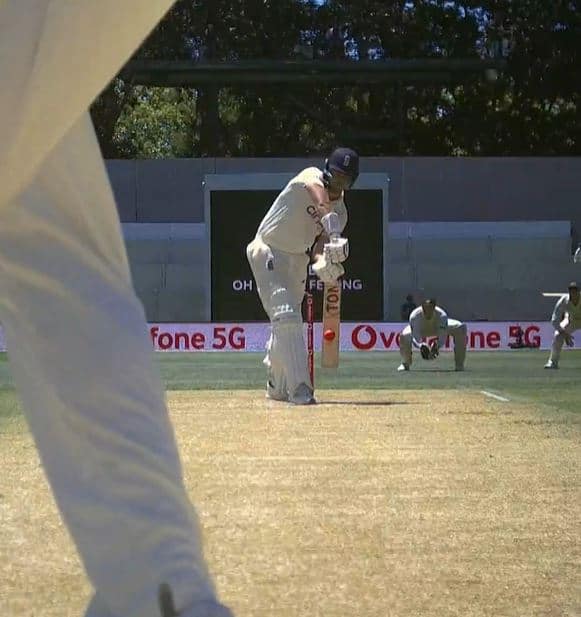As a bowler in cricket there’s a lot of pressure on you to bowl challenging lines and lengths to the batsmen. A bowler who can do this regularly is one who is much more likely to cause problems for the batting side, and as a result they’ll probably end up taking a lot more wickets!
So, what is a good line and length? Well, most coaches and people involved in the game will tell you that a ball that hits the top of the off stump is the perfect line and length. Why is this? When it comes to the line, an off stump line forces the batsman into a shot because they believe that if they leave the ball, it could hit the stumps. As for the length, a ball that passes the batsman at around the height of the top of the stumps is challenging because it makes it hard for the batsman to know whether to play on the front or back foot. This indecision can slow down a batsman’s footwork and force them into a mistake!
When a bowler gets things wrong and ends up getting smashed for a boundary, you may hear people say that they bowled an ‘overpitched delivery’. If you’ve heard this and you’re not sure what it means, then I’m going to explain it for you today. We’ll cover what it is, what sorts of shots a batsman can play against one, and how to avoid bowling them. If that sounds like it’d be interesting for you, make sure you read to the end of this post. Let’s get into it!
So, what is an overpitched delivery in cricket?
An overpitched delivery is a ball bowled by any type of bowler that bounces slightly in front of the batsman’s feet. When the ball reaches the batsman, it will usually be lower than knee-height, making it easy for them to hit the ball aggressively. These deliveries can also be referred to as ‘half volleys’
For professional fast bowlers, a ball that hits the top of the stumps is often referred to as a ‘good length’ ball because it is the most challenging length a bowler can bowl. These kinds of deliveries will often pitch around 6-7 metres away from the stumps of the batsman, in the yellow ‘good length’ zone that is shown in the diagram below. An overpitched delivery usually pitches in the blue ‘full length’ zone, roughly between 2-3 metres away from the stumps. For spin bowlers and for younger players that don’t bowl as fast, an overpitched delivery will bounce a bit closer to the batsman.

Even though I’ve mentioned that it’s a lot easier for a batsman to strike an overpitched delivery and hit it for a boundary, that doesn’t mean that it’s a completely useless ball. Of course, there’s always the chance that the batsman could miss an overpitched delivery targeting the stumps and get out bowled or LBW or could try to slog it for six and get caught by a deep fielder. The point is to say that bowling overpitched deliveries puts the odds in the favour of the batsman, rather than the fielding side, and that bowlers should try to avoid them if possible – especially in limited overs cricket!

If the ball is swinging significantly, overpitched deliveries can be a lot more dangerous. The presence of swing makes it very hard for the batsman to judge which line the ball will be on when it reaches them, so as a result it is harder to play aggressive shots. For example, if the ball is on a leg stump line when it leaves the bowlers hand, but it then swings late onto an off stump line, it would be harder for a batsman to confidently play an aggressive shot to this ball due to the change in line! When the ball is not swinging overpitched deliveries are much easier to attack because the batsman knows exactly what line the ball is going to be on.
What Is The Difference Between An Overpitched Delivery and a Yorker?
As we’ve discussed, an ‘overpitched delivery’ will bounce in front of the batsman and will have bounced up to about shin height by the time it reaches the batsman. A yorker is slightly different! The intention when bowling a yorker is to deliver the ball so that it hits the line of the popping crease (or the batsman’s feet) without bouncing at all! If you look at the diagram below again, you’ll see that a delivery that lands in the ‘yorker length’ zone is much closer to the stumps than an overpitched delivery would be.

Because a yorker lands so close to the feet of the batsman and is basically hitting the floor as it reaches them, it is incredibly difficult for the batter to get underneath the ball or time it well enough to hit it for four or six. This is why this type of delivery is so popular in limited overs cricket like T20’s and ODI’s! If you’d like to learn more about yorkers, including why they’re so useful and how to bowl them – click here to read my article covering that!
How To Avoid Bowling Overpitched Deliveries?
Now that we know that bowling overpitched deliveries is not ideal – especially in short formats of cricket – many bowlers will be wondering how they can avoid bowling them. The simple answer is that all bowlers need to spend plenty of time working on their bowling accuracy and their ability to bowl accurate lines and lengths.
If you want some ideas as to how you can work on this, have a look at the list below:
- Use target practice drills during your net sessions
- Make sure you’re practicing your bowling regularly – multiple times a week if possible!
- Focus on an area of the pitch as you run in to bowl
- Use your front arm to assist your aim
If you want to read more about the steps above and get a few extra tips to improve your accuracy, click here to read my ‘improving your line and length’ post! That article should have all you need to start making some vital changes to your practice methods and your bowling technique that will aid your ability to bowl good lines and lengths.
What Shots Can A Batsman Play To An Overpitched Delivery?
A batsman can play a huge range of shots to an overpitched ball. The choice of shot will depend on what line the overpitched delivery is bowled on. Let’s have a look at some examples below and see what shots could potentially be played to each.
Outside Off Stump Line
Here are a few shots a batsman could play to an overpitched delivery that’s outside the line of off stump (all of these shots can be played along the ground or in the air):
- Square drive
- Cover drive
- Reverse sweep
- Forward Defence
- Glide Down To Third Man
Middle/Off Stump Line
Here are a few shots a batsman could play to an overpitched delivery that’s on the line of middle or off stump. Once again, all of these shots can be played along the ground or in the air:
- Straight Drive
- Cover Drive
- On Drive
- Sweep
- Reverse Sweep
- Mid-wicket flick
Leg Stump Line
Here are a few shots a batsman could play to an overpitched delivery that’s on a leg stump line. Again, all of these shots can be played along the ground or in the air:
- On Drive
- Straight Drive
- Mid-Wicket Flick
- Leg Glance
- Sweep
If you’d like to know any more about these shots and types of cricket shots in general – I’d recommend reading my post linked here!
Conclusion
I hope this post has helped you uncover the information you were looking for. In my opinion, it is best for bowlers to avoid bowling overpitched deliveries in limited overs formats of cricket, but if there is plenty of swing and movement present, it could be worth trying a couple early on in the innings!
If you have any other burning questions about the sport of cricket, head over to my ‘General Cricket Questions’ page – I’m sure you’ll find plenty of interesting stuff there!
